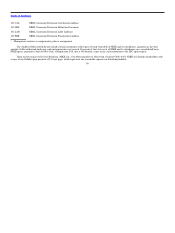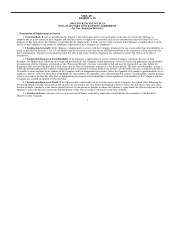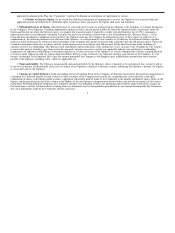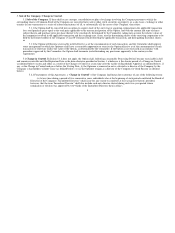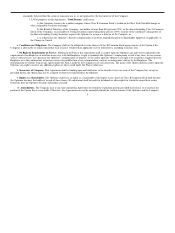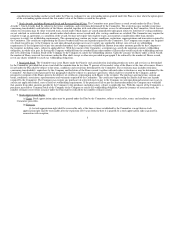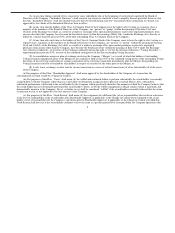Nike 2010 Annual Report Download - page 110
Download and view the complete annual report
Please find page 110 of the 2010 Nike annual report below. You can navigate through the pages in the report by either clicking on the pages listed below, or by using the keyword search tool below to find specific information within the annual report.
(b) At any time that the holders of the Class A Common Stock of the Company have the right to elect (voting as a separate class)
a majority of the members of the Board of Directors of the Company, any “person” or “group” (within the meaning of Sections 13(d)
and 14(d)(2) of the Exchange Act) shall, as a result of a tender or exchange offer, open market purchases or privately negotiated
purchases from anyone other than the Company, have become the beneficial owner (within the meaning of Rule 13d−3 under the
Exchange Act), directly or indirectly, of more than fifty percent (50%) of the then outstanding Class A Common Stock of the Company;
(c) At any time after such time as the holders of the Class A Common Stock of the Company cease to have the right to elect
(voting as a separate class) a majority of the members of the Board of Directors of the Company, any “person” or “group” (within the
meaning of Sections 13(d) and 14(d)(2) of the Exchange Act) shall, as a result of a tender or exchange offer, open market purchases or
privately negotiated purchases from anyone other than the Company, have become the beneficial owner (within the meaning of Rule
13d−3 under the Exchange Act), directly or indirectly, of securities of the Company ordinarily having the right to vote for the election
of directors (“Voting Securities”) representing thirty percent (30%) or more of the combined voting power of the then outstanding
Voting Securities;
(d) A consolidation, merger or plan of exchange involving the Company (“Merger”) as a result of which the holders of
outstanding Voting Securities immediately prior to the Merger do not continue to hold at least 50% of the combined voting power of the
outstanding Voting Securities of the surviving corporation or a parent corporation of the surviving corporation immediately after the
Merger, disregarding any Voting Securities issued to or retained by such holders in respect of securities of any other party to the
Merger; or
(e) A sale, lease, exchange, or other transfer (in one transaction or a series of related transactions) of all or substantially all of the
assets of the Company.
5.2.2 For purposes of this Agreement, “Shareholder Approval” shall mean approval by the shareholders of the Company of a
transaction, the consummation of which would be a Change in Control.
5.2.3 For purposes of this Agreement, “Cause” shall mean (a) the willful and continued failure to perform substantially the Optionee’s
duties as a director of the Company (other than any such failure resulting from incapacity due to physical or mental illness) after a demand for
substantial performance is delivered to the Optionee by the Company which specifically identifies the manner in which the Company believes
that the Optionee has not substantially performed the Optionee’s duties, or (b) the willful engagement in illegal conduct which is materially and
demonstrably injurious to the Company. No act, or failure to act, shall be considered “willful” if the Optionee
4



